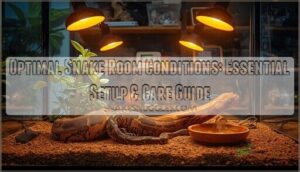This site is supported by our readers. We may earn a commission, at no cost to you, if you purchase through links.

Most snakes thrive with once or twice weekly touch sessions, but your specific snake’s species, age, and personality matter far more than any blanket rule. Getting this balance right transforms your relationship with your pet—turning defensive strikes into calm exploration and building the confidence you need as a caretaker.
Table Of Contents
Key Takeaways
- Most pet snakes thrive with once or twice weekly handling sessions, but species differences matter significantly—ball pythons need more conservative interaction (1-3 times weekly under 20 minutes) while corn snakes tolerate twice-weekly contact better.
- Avoid handling your snake entirely during three critical periods: the 24-48 hours after feeding to prevent regurgitation, during shedding cycles when vision is impaired and stress peaks, and whenever you spot illness signs like respiratory distress or unexplained weight loss.
- Regular handling builds trust and reduces defensive behavior by teaching your snake you’re not a threat, while also providing physical exercise, mental stimulation, and early detection opportunities for health issues.
- Quality beats quantity—one focused 10-15 minute session per week outperforms rushed daily interactions, and watching your snake’s body language (defensive posturing, hissing, rigid coiling) tells you when to back off regardless of your schedule.
How Often Should You Handle a Snake?
Most pet snakes thrive with interaction once or twice a week, but the right frequency depends on your snake’s species, age, and personality. Ball pythons need different care than corn snakes, and a shy juvenile won’t tolerate the same schedule as a calm adult.
Let’s break down exactly how often you should reach for your scaly friend.
General Frequency Guidelines for Pet Snakes
Most pet snakes thrive with once-weekly interaction sessions, though the ideal range can stretch from one to three times per week depending on your snake’s personality and your goals as a keeper.
Here’s what balanced interaction schedules look like:
- Weekly baseline: One session per week maintains snake socialization without overwhelming most species
- Frequency limits matter: Daily interaction can stress even docile snakes; respect their need for downtime
- Quality over quantity: Fifteen focused minutes beats rushed, frequent interactions for pet snake care
- Owner responsibilities include observation: Watch body language to fine-tune your snake interaction routine
Differences by Species (Ball Python, Corn Snake, Etc.)
Not all snakes share the same tolerance for human interaction—breed characteristics and species temperament play significant roles. Ball pythons require a more conservative approach: limit contact to 1–3 times weekly, with sessions under 20 minutes, as they are prone to stress-related feeding refusal. Corn snakes, in contrast, are the easygoing champions of snake contact; they tolerate twice-weekly sessions better and exhibit calmer behavior during interaction. Understanding safe contact techniques is vital for building trust with your pet snake.
Here’s a quick species comparison for contact techniques:
| Species | Recommended Frequency |
|---|---|
| Ball Python | 1–3 times per week |
| Corn Snake | 1–2 times per week |
| Boa Constrictor | 1–2 times per week |
| King/Milk Snake | 1–2 times per week |
Boas display strong gripping—a sign of muscular engagement, not aggression—so keep sessions under 30 minutes. King and milk snakes tend to be defensive, especially as juveniles, requiring patience and shorter contact periods to build trust through proper snake care.
Factors Affecting Handling Frequency (Age, Temperament, Health)
Beyond species traits, three critical variables shape your management routine: Snake Age Factors determine session length—juveniles need brief, frequent contact (2–4 times weekly for 5–10 minutes) to reduce defensive striking, while adults tolerate weekly 20-minute sessions. Temperament Tests reveal exploratory versus defensive personalities; snakes displaying calm behavior during Management Stress assessments can manage more interaction.
Health Monitoring is non-negotiable—respiratory infections, parasites, or lethargy demand zero contact until veterinary clearance, protecting both Snake Health and recovery outcomes through proper Snake Behavior observation.
Understanding the concept of social buffering effects can also inform management practices to minimize stress on the snake.
Best Practices for Safe Snake Handling
Managing your snake the right way keeps both of you safe and builds trust over time. Before you pick up your pet, you’ll want to know how to prepare, what techniques work best, and when to back off.
Let’s walk through the essentials that turn nervous managers into confident ones.
Preparing to Handle Your Snake
Before you even open that enclosure, your prep work can make the difference between a smooth session and a stressed-out snake. Wash your hands thoroughly—snake hygiene matters—then apply hand sanitizer to remove food scents. Check your snake’s behavior through the glass: if it’s coiled defensively or actively hunting, wait.
Gather any manipulation tools you might need, verify the snake habitat is secure, and give yourself a mental runway for calm, confident animal manipulation and safety.
Proper Handling Techniques
Once you’ve got your snake in hand, the way you support its body often determines whether it feels secure or starts thrashing for an exit. Use gentle restraint across multiple points—let it glide between your palms, distributing weight evenly. Keep movements slow and predictable; sudden shifts trigger defensive reflexes.
Support the midsection and tail while allowing the head freedom to explore. This taming method builds snake temperament and confidence, making every reptile management session safer for both of you.
Signs Your Snake Wants to Be Left Alone
Your snake will often signal its mood long before you reach into the enclosure—watch for coiled tension, rapid tongue flicks, or that telltale S-curve posture that says ‘not today.’ If your ball python curls into a tight ball or hisses, respect those stress signals.
Understanding reptile behavior and snake body language means honoring isolation needs, reducing touch stress, and letting your pet decompress—sometimes alone time is exactly what snake behavior demands.
When to Avoid Handling Your Snake
Knowing when to step back is just as important as establishing a regular interaction routine. Your snake will give you clear signals when it needs space, and ignoring these moments can stress them out or even lead to defensive bites.
Let’s look at the three main situations where interaction should be off the table.
After Feeding and During Digestion
Think of a snake’s digestive system like a construction zone—disturbing the site mid-project is a recipe for disaster. After feeding, wait 24–48 hours before touching to protect your snake’s digestive health and prevent regurgitation.
This post-meal care window ensures proper snake nutrition and reduces stress. Respecting feeding schedules and digestion time is critical for snake safety, overall health and wellness, and long-term feeding and nutrition success—your touching tips should always prioritize digestive health over your schedule.
During Shedding Periods
When your snake’s eyes turn cloudy and its skin looks dull, it’s entering a vulnerable phase where touching can feel like sandpaper on a sunburn. Shedding cycles demand extra touching precautions—your snake can’t see well and feels defensively exposed. Skip touching entirely during this time to support skin health and stress reduction.
Ball Python care during shedding:
- Boost humidity levels to 70–80% for a clean shed
- Watch for blue-phase eyes signaling snake health and wellness needs
- Resume snake touching only after the shed completes fully
- Prioritize shedding comfort over your interaction schedule
Signs of Stress or Illness
If your snake refuses food for weeks, stays hidden constantly, or shows labored breathing, these stress signals and illness indicators demand immediate attention. Snake behavior changes—defensive striking, lethargy, or abnormal postures—require careful health monitoring before any snake management occurs.
Reptile health and safety depends on recognizing when snake biology shifts from normal to concerning. Skip management and contact veterinary care when you spot respiratory distress, regurgitation, or unexplained weight loss affecting snake health and wellness and animal management and safety.
Benefits of Regular Snake Handling
Managing your snake regularly isn’t just about keeping it tame—it’s about building a healthier, more confident animal. When done right, consistent interaction strengthens your bond, reduces defensive behavior, and keeps your snake physically and mentally sharp.
Here’s what you gain from making management a regular part of your routine.
Building Trust and Reducing Aggression
Regular interaction isn’t just about taming your snake—it’s the single most effective way to turn a defensive hatchling into a calm, predictable adult that doesn’t flinch at your presence. Through consistent, gentle interaction techniques, you’re teaching your snake that you’re not a threat.
Ball python behavior shifts dramatically with this trust building—what starts as defensive posturing becomes relaxed tolerance. Watch for aggression signs to fade as your snake’s temperament mellows with each session.
Supporting Physical and Mental Health
Beyond trust, functioning acts as your snake’s gym and enrichment center rolled into one—movement across your hands and arms provides the kind of physical exercise that no enclosure can fully replicate, while the novel sensory input keeps their mind engaged and alert.
Here’s what regular snake interaction delivers for reptile care and management:
- Mental stimulation through changing textures and temperatures
- Health monitoring—you’ll spot weight changes or injuries early
- Environmental enrichment beyond static habitat features
- Stress reduction as predictable routines build confidence
Animal interaction and safety practices turn routine interaction into preventive care.
Socialization and Habituation
The real magic of managing isn’t just what it does for your snake today—it’s how each calm session rewires their survival instincts, gradually teaching them that your presence means safety rather than danger. This habituation process—the foundation of effective taming methods—transforms defensive ball python behavior into curiosity.
Consistent snake management and care builds snake bonding through repeated low-stress exposure, proving that social learning works even in solitary reptiles when paired with smart environmental enrichment.
Snake Handling Tips for Families and Beginners
If you’re new to snake ownership or introducing your family to interaction, a few simple strategies can make all the difference. The right approach keeps everyone safe while helping your snake adjust to human interaction.
Let’s walk through three practical areas that’ll set you up for success.
Supervising Children and New Handlers
Kids and first-time caretakers often need more coaching than you’d expect—even with a docile species like a ball python. Here’s your family management rules checklist:
- Always supervise children closely—keep the snake’s head away from faces and necks for child safety tips that actually work.
- Teach proper support techniques first—new owner guidance starts with two-handed holds that prevent drops.
- Set a 10-minute limit initially—caretaker training builds confidence without overwhelming anyone.
These supervision techniques make reptile management safe and enjoyable for everyone learning animal management and safety basics.
Hygiene and Safety Precautions
Washing your hands before you pick up your snake isn’t just good manners—it’s a simple habit that prevents bites and keeps both of you healthy. Use hand sanitizer afterward to mask food smells that trigger feeding responses.
This secure management practice protects you from snake bites while reducing bacteria transfer during reptile management sessions—your basic personal protection checklist every time you practice animal management and safety.
Creating a Positive Handling Routine
Building consistency into your care routine—even if it’s just ten minutes twice a week—transforms your snake from skittish to steady over time. Choose the same days for reptile interaction so your snake anticipates gentle interaction rather than viewing your approach as a threat.
This routine scheduling aids stress reduction while improving snake temperament through predictable animal interaction and safety practices that build trust through measured, consistent snake care and attention.
Frequently Asked Questions (FAQs)
Can you handle snakes during breeding season?
Ironically, snakes become less interested in your company when romance is in the air.
Yes, you can manage snakes during breeding season, but expect defensive behavior and reduced tolerance—hormones drive mating rituals over human interaction, so shorter, gentler sessions protect both reproductive health and your fingers.
How long should each handling session last?
Most sessions work best at 10–15 minutes for adults—just enough for interaction without fatigue. Juveniles do better with 5–10 minutes since touching causes more stress.
Watch for defensive cues like tail rattling or rigid posture, then wrap up the session early.
What time of day is best for handling?
Manage your snake during evening hours when nocturnal species like ball pythons are naturally active. Their circadian rhythms align with nighttime behavior, making evening interactions less stressful and more predictable than morning management or daytime care attempts.
Should you handle snakes before or after enclosure cleaning?
Before you disturb your snake’s space with cleaning supplies, touch it first. This approach keeps stress low because snakes feel unsettled when their territory suddenly smells different or looks rearranged—touching afterward just adds another layer of disturbance they don’t need.
How does room temperature affect handling frequency?
Room temperature directly impacts your snake’s energy levels and digestive function. If ambient conditions are too cool, your snake becomes sluggish and stressed—making interaction sessions less safe and more taxing on its system.
Conclusion
Think of your snake like a wild plant you’re coaxing into a garden—forcing daily interaction burns trust faster than drought kills roots, but complete neglect leaves potential untapped. How often you interact with your snake determines whether it sees you as predator or protector.
Start with once-weekly sessions, watch your snake’s body language like a conversation, and adjust from there. The snakes that thrive aren’t the ones interacted with most—they’re the ones interacted with thoughtfully, with patience that mirrors their own deliberate pace through life.
- https://www.reddit.com/r/snakes/comments/avg6kw/whats_a_good_schedule_to_get_a_snake_used_to/
- https://www.petmd.com/reptile/general-care/how-to-pick-up-a-snake
- https://community.morphmarket.com/t/how-often-do-you-handle-your-reptiles/12350
- https://novapublishers.com/wp-content/uploads/2023/08/Chapter-11.pdf
- https://www.sciencedirect.com/science/article/pii/S1095643322000204












